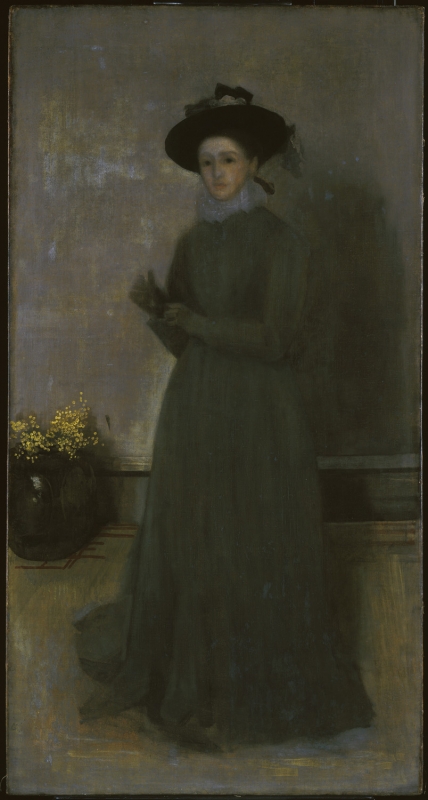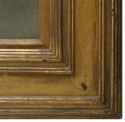Home > Catalogue > People > Rachel Alexander (related works) > Catalogue entry
Composition
W. C. Alexander had suggested that May should pose in riding habit, and Whistler agreed, but suggested the addition of a hat made for the occasion. He wrote to Mrs Alexander:
'[T]here is a shop in South Audley Street, No. 63 - Milton & . . . something, who have charming felt hats, and feather "picture hats" they call them[,] such as you cannot get elsewhere - Perhaps if you were to ask you might see something lovely for May - large I should have it - with a big soft brim - looped up - however they know all about it - it is there [sic] speciality and doubtless will show you some lovely ones all bravely gotten up with large feather I suppose for I think it would be charming to paint May with the hat on, the feather swooping grandly away! ...
... The habit will be black I suppose - and the hat black felt or grey with white feather and black arrangement - Don't be afraid of having it too big - The Leyland children have hats from the South Audley street [shop], and if you were to say that Mrs Leyland recommended you to go there they will at once understand the sort of thing you wish and do their best.' 1
The shop, Walker and Milton, milliners, was close to Grosvenor Square.
There are two related drawings. A pen and wash drawing, Study for 'Portrait of Miss May Alexander' [M.0499], signed with a butterfly of ca 1874, closely resembles the final composition of May's portrait, but shows her with a riding crop under her left arm. She is standing on a tiled floor, with a large round pot of flowers behind her, at left. She wears a grey pleated dress with close-fitting buttoned top, and a big 'picture hat' with ribbons. These details were simplified and lost in the painting, so that the figure and dress harmonised with the background. 2
The other, a pen sketch, Study for 'Portrait of Miss May Alexander' [M.0498], drawn on paper belonging to F. R. Leyland, is closer to the final composition, and shows her with her riding crop held diagonally out to left. The background is dark and she fades into it, except for her face and a sweeping feather on her hat.
Study for 'Portrait of Miss Leyland' [M.0501], showing a young woman in riding habit, seems to correspond most closely to the missing Portrait of Miss Leyland (2) [YMSM 110].
Yet another pen drawing, Study for 'Portrait of Miss Leyland' [M.0502], showing a girl in a white flounced dress, was thought by the Pennells to be a study for May's portrait, and could have been an idea for a portrait of May Alexander or Fanny Leyland or another young woman. 3
Riding habit appealed to Whistler for its simplicity of colour and line and appears in several portraits, the most important being Arrangement in Brown and Black: Portrait of Miss Rosa Corder [YMSM 203] and Arrangement in Black, No. 8: Portrait of Mrs Cassatt [YMSM 250]. 4
Technique
It is painted extremely thinly, and some areas obviously rubbed down. The ghost-like face is particularly insubstantial. There are, however, vivid touches and free brushstrokes depicting some details.
A thorough examination of the canvas by Professor Joyce H. Townsend at Tate Britain resulted in the following detailed report:
'The painting has been lined with wax/resin and is in its original format, evidenced by the cusping marks that reveal its original attachment to a stretcher with tacks, though not on its original stretcher. The canvas is very coarse, with 10 threads per centimetre in the vertical direction and 15 in the horizontal direction. It was presumably sized, but was not primed before stretching. Whistler applied a very thin grey layer, which barely fills the hollows between the canvas threads, and which is not obvious on close examination. This may be underpainting beneath the figure and the vase of flowers, rather than an imprimatura which would cover the whole canvas. It is made from lead white, coarse bone black, a yellow pigment and traces of some other colours.
X-radiography does not suggest any major compositional changes. It shows clearly that Whistler scraped and rubbed much of the surface. The hat was reduced on the sitter’s right by scraping, and on the left by wiping off paint, while its crown was also lowered slightly. Something was painted out at her left ear and shoulder. Its original amplitude and height would have been closer to the sketched hats. Two buttons on the bodice were overpainted, and there is a suggestion that the neckline more resembled a deep shawl collar in an earlier version. The skirt has not been narrowed, but may have been widened in the course of painting. The eyes and eyebrows appear prominent in the X-radiograph because there is very little paint in these areas; Whistler painted the lighter areas of the face and left the eyes virtually unpainted.
From a study of the surface, it is difficult to distinguish the dress fabric from the background, since the pigments used to paint them are the same for both areas. Each application of paint was rubbed down before the next was applied. The background is a single layer, the sitter’s shadow being applied on top. The skirting board was created with additional layers applied over the background. The paint medium was highly thinned, and it has yellowed. This is a feature seen in much of Whistler’s highly-thinned paint, but such yellowing is not universal in paint of this date, hence it is a consequence of his choice of paint medium and thinners.
Rose madder, another red lake not further identified, Mars red and orange (a synthetic, brightly coloured form of iron oxide), cadmium yellow and possibly barium chromate, dark umber, a reddish/brown ochre, cerulean blue and Prussian blue were identified. These generally occur in mixtures, even in the more colourful areas such as the flowers, which establish a colour harmony.' 5
Conservation History
A photograph of it taken in 1908 shows that it has darkened: it appears much sunken in, rubbed down, and abraded. The face, in particular, is extremely faint and characterless.
Professor Townsend adds:
'The painting was varnished within a frame in the past, and in 1963 was varnished at Tate. Residues of several varnishes are present, all apparently of natural resin type, collectively very yellow in tone and with a fine crack pattern on the scale of the canvas threads.
The combined effects of yellowed medium, yellowed varnish, and lining adhesive impregnation of the very thinly-painted canvas, made the surface appear darker, more yellow-green and somewhat flatter than it would have originally. The mid-toned underpainting exacerbates the darkening which would have been less dramatic had a white priming been used. Varnish removal could not alleviate the darkening completely, and the painting has not therefore received conservation treatment for some decades.' 6
Frame
Flat Whistler frame, possibly the painting’s first frame (circa 1875-1888) designed by Whistler: gold leaf (oil and water gilding) on wood (oak on pine). 7
This frame’s frieze (the broad flat between the reeded mouldings) shows evidence of an earlier gilded decorative scheme, which may also have had a painted pattern later removed by Whistler, or on his instructions. It may have been modified in 1898 for exhibition.
Notes:
1: Whistler to R. A. Alexander, [September/October 1874], GUW #07583.Pennell 1908 [more] , vol. 1, p. 175. MacDonald 2003 [more] , p. 124.
2: MacDonald 2003 [more] , p. 124, repr.
3: Pennell 1908 [more] , vol. 2, f.p. 237.
4: MacDonald 2003, op. cit., p. 124.
5: Prof. J. H. Townsend, report, November 2017.
6: Townsend 2017, op. cit.
7: Dr Sarah L. Parkerson Day, Report on frames, 2017; see also Parkerson 2007 [more] .
Last updated: 31st December 2020 by Margaret











